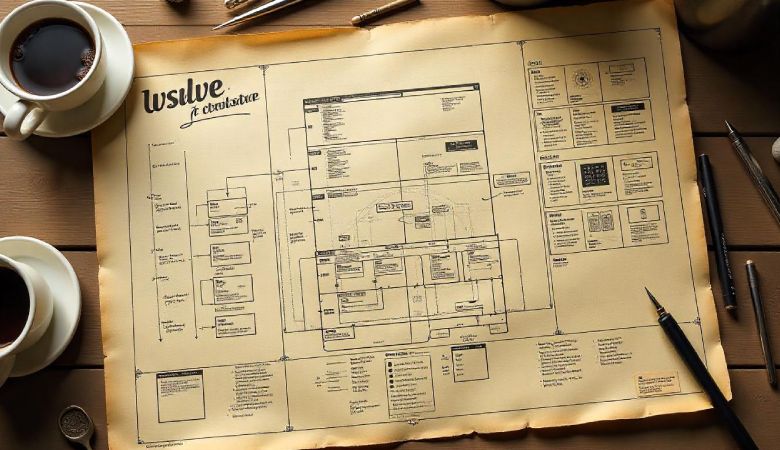How to Build a Better, Smarter, More Discoverable Site Architecture
Have you noticed your website traffic dropping over the past few years?
Many websites struggle with messy page layouts, missing links, and confusing navigation. This can make it hard for both users and search engines to find important pages.
The good news? You can fix your website’s structure to make it easier to navigate and improve your search rankings.
This guide will give you simple steps to improve your site’s layout and help search engines understand your most important pages.
Why Website Structure Matters
About a year ago, Google’s Gary Illyes mentioned that Google is now crawling fewer pages. This means having a clear and organized site is more important than ever. Google’s updated SEO Starter Guide also highlights the importance of linking to your key pages. They are telling us exactly what they want to see!
In SEO Office Hours, Illyes also shared that:
- Google prefers a structured website with clear categories.
- Some sections, like /news/, may be crawled more often than others, like /archive/.
- If everything is in one folder, it may be harder for Google to understand your site.
Google has given us these valuable tips—now let’s use them to improve your website!
3 Signs of Poor Website Structure (According to Google)
A well-organized website helps users and search engines find important pages. If your site is not structured well, Google may struggle to understand it. Here are three signs that your site architecture needs improvement.
- Sitelinks Issues: Sitelinks show important pages under your website’s main search result. If some key pages are missing, it could mean your site lacks proper internal linking or structure. Since Google decides which links to show, you should improve your internal linking to increase visibility.
- Subdomains Getting Crawled More Than Your Main Site: Google Search Console’s crawl stats can reveal if Google is spending too much time on less important pages. If subdomains are using up most of the crawl requests instead of your main pages, it might be a sign that your site’s structure needs adjustments.
- Missing Breadcrumbs: Breadcrumbs help users navigate your site and show Google how pages are connected. If your site lacks breadcrumbs, it may be harder for search engines and users to understand your content. Google has been emphasizing their importance, so make sure every page includes them.
Using Screaming Frog to Improve Your Website Structure
Screaming Frog offers tools to visualize how search engines crawl your website.
Crawl Diagrams:
- Show the shortest path from your homepage to other pages.
- Help you see how easy it is for Google to reach important content.
- Dark green circles indicate pages that are easy to reach (fewer clicks).
- Red circles show pages that are not indexed.
Directory Diagrams:
- Display how your URLs are grouped in folders.
- Help identify if content is buried too deep in unnecessary directories.
Good vs. Bad Website Structure in Crawl Diagrams
A well-structured website helps both users and search engines. Here’s how crawl diagrams show the difference between good and bad site architecture:
Good Site Structure
- Pages are grouped neatly into clear topics.
- Green nodes (representing pages) are evenly spread.
- There are some low-priority pages, but they don’t disrupt the structure.
Bad Site Structure
- Pages are scattered with no clear organization.
- Many dark nodes indicate that important pages might not be prioritized correctly.
- Users may struggle to navigate, leading to a poor experience.
No matter how great your product images or landing page designs are, if your site is hard to navigate, users will have a frustrating experience.
Improve Your Site Structure Using Screaming Frog & Google Search Console
Connecting Google Search Console to Screaming Frog gives you insights into the pages getting the most clicks.
Steps to Improve Click Data Analysis
- Check your most-clicked pages – Which pages do users visit the most?
- Look at keywords – What search terms bring users to these pages?
- Identify orphan pages – Are there important pages without internal links?
Fixing Blog Navigation Issues
If users struggle to find important blog categories, here’s how to fix it:
- Update your XML sitemap to list category pages.
- Improve the blog menu to highlight popular categories.
Use Google Analytics 4 to Understand User Behavior
GA4’s path exploration report shows how users move through your site.
- You can see which pages they visit after landing on your homepage.
- If users keep switching between two pages (e.g., Page A → Page B → Page A), this might mean they can’t find what they need.
Using ChatGPT to Build a Better Site Navigation
ChatGPT can help create a navigation structure and URL map for your website.
Steps to Use ChatGPT for Site Structure
- Use the prompt: “Create a navigation structure document.”
- Answer questions about your target audience and preferred layout.
- Copy the final structure into a wireframe tool like Relume, which generates a visual layout.
- Ask ChatGPT to create a URL map based on your structure.
4 tips to remember when building your main navigation
1. Order Matters: Left to Right
People naturally read from left to right, and search engines try to follow this pattern when crawling websites. Because of this, the items you place at the beginning and end of your navigation menu are the most important. Users tend to remember these sections the most, a concept known as the serial-position effect.
To make navigation easier, keep your main categories limited to around 7 items. If you have subcategories in a dropdown menu, try to keep them under 10 to prevent overwhelming visitors. A well-structured menu helps both users and search engines find the most important pages quickly.
2. Show Users Where They Are
A good navigation menu makes it clear which section of the website a user is currently on. Highlighting the active page in the main navigation helps users understand the website structure and move to other sections easily.
Without this, users may feel lost and struggle to find the information they need. Simple visual cues, like bold text or a different color for the active section, can improve navigation and create a better browsing experience.
3. Search Engines Crawl by Page Type
Google does not always crawl a website as one big structure. Instead, it looks at different types of pages separately. For example, product pages that are well-organized with breadcrumbs, clear content, and fast load times may be grouped and ranked differently than blog pages.
By optimizing important pages separately, such as product pages or service pages, you can improve their visibility in search results. This strategy helps ensure that the most valuable parts of your site get the attention they deserve.
4. Use Sentence Case for Navigation
Many websites make the mistake of using ALL CAPS in their main navigation, thinking it makes their menu look bold and professional. However, Google’s best practices suggest using sentence case (where only the first letter is capitalized) because it improves readability.
In addition, some accessibility tools read text letter-by-letter when it is in all caps, making it harder for visually impaired users. Sticking to sentence case makes your navigation easier to read and improves accessibility for all visitors.
Case Study: A Site Gained 131% More Traffic in 3 Months
A website lost 45% of its organic traffic after making poor changes to its site structure. They removed subfolders, changed the main navigation, and broke internal links, which confused both users and search engines.
After struggling with low traffic for a year, they brought in an SEO expert. By fixing the navigation, URL structure, and internal links, they saw a 131% increase in traffic within three months. This case proves that good site structure plays a huge role in search rankings and user experience.
How to Get Approval for Site Changes
If you need approval from decision-makers to improve your website’s structure, focus on how it affects business goals. For example, if small navigation improvements lead to a 5% increase in trial downloads, this could result in 31% more revenue.
Showing a clear return on investment (ROI) can convince leadership to invest in these changes. Even after considering costs like tools and user testing, the long-term benefits far outweigh the expenses. When presenting your case, use numbers and business terms so decision-makers understand the impact.
Partner with our Digital Marketing Agency
Ask Engage Coders to create a comprehensive and inclusive digital marketing plan that takes your business to new heights.
Contact Us
The Future of Site Navigation
Website navigation is evolving, and conversational navigation is becoming more popular. Tools like Hume AI are already making it possible for users to find information through chat-based interactions. Instead of clicking through menus, visitors may soon be able to ask a question and be guided to the right page instantly.
While this technology is still developing, clear site structure, simple navigation, and well-organized content remain the best ways to make a website easy to use today. By improving your site now, you prepare for a future where smart navigation will play a bigger role in user experience.








